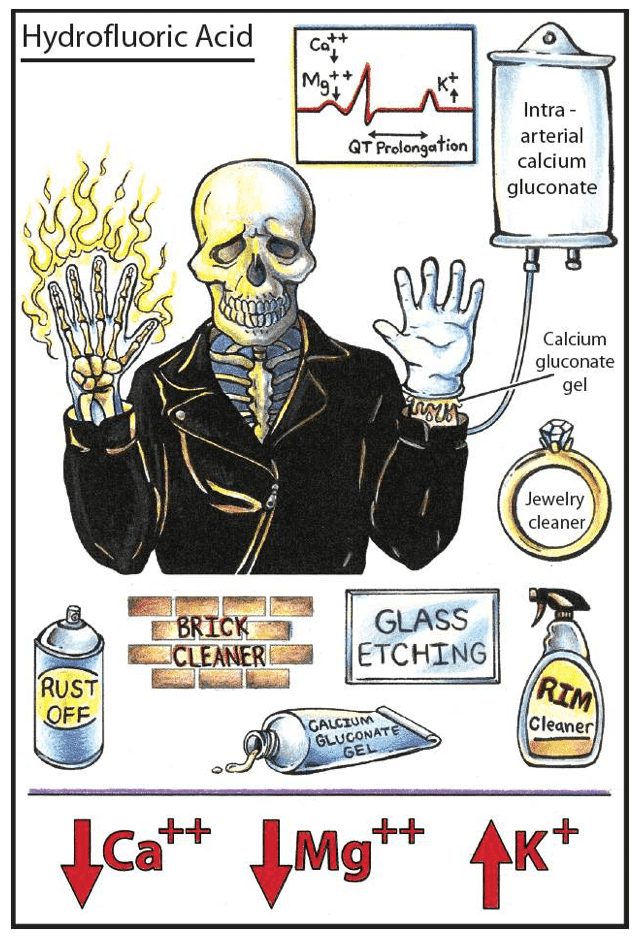Hydrofluric acid
Hydrofluoric acid is found in car wheel cleaners, rust removal and glass etching solutions. Classically the person will present with pain out of proportion hours after dermal exposure. Unfortunately exposure can occur in almost every route and toxicity can be life threatening due to ventricular dysrhythmias secondary to hypocalcaemia, hyperkalaemia and hypomagnesaemia.
Toxic Mechanism:
Fluoride ions bind directly with calcium and magnesium as well as disrupting potassium channels causing cell dysfunction and death. Ventricular dysrhythmias occur secondary to hypocalcaemia, hyperkalaemia and hypomagnesaemia and acidosis.
Toxicokinetics:
- Rapid absorption after ingestion or dermal contact.
Resuscitation:
- Ventricular dysrhythmias / Cardiac Arrest:
- Commence advanced cardiac life support
- Intubate and hyperventilate
- Administer calcium gluconate 10% 60ml (0.6 – 1.0 ml/kg in children) or calcium chloride 10% 20 ml (0.2 ml/kg in children) IV and repeat every 5 minutes until return of spontaneous circulation. Ongoing administration may be required to maintain a calcium concentration >1 mmol/L
- Administer sodium bicarbonate 100 mEq IV (3 mEq/kg in children)
- Administer magnesium sulphate 10 mmol IV (0.05 mmol/kg in children)
Risk Assessment
- This can be look complex due to different routes and concentrations. The following are some simple rules before we talk specifics:
- Any dermal/ocular injury can cause severe pain
- Inhalation can cause pulmonary injury
- Ingestion of >100 ml low concentration HF (6%) can cause life-threatening toxicity
- Ingestion of any volume of higher concentrations of HF can cause life-threatening toxicity
- Specific dermal exposures at risk of life-threatening toxicity:
- 100% HF solution to 2.5% body surface area
- 70% HF solution to 8% body surface area
- 23% HF solution to 11% body surface area
- Domestic HF is usually between 5 – 12%. Industrial HF is more concentrated.
- Children: Any ingestion of HF is potentially lethal.
- Clinical features:
- Dermal:
- If concentrations of <50% in contact with the skin then there is often a delay in pain by several hours. The lower the concentration the greater the delay. Patients often present at night or the next day following exposure.
- Deep pain without any erythema or blistering is typical
- Pallor, blanching, blistering or tissue loss often appears hours or days later.
- Pain usually lasts 24-36 hours.
- Inhalation:
- Immediate mucosal irritation followed by delayed dyspnoea, cough and wheeze.
- Non-cardiac pulmonary oedema can occur in severe cases.
- Ingestion:
- <20% HF is minimally corrosive
- Vomiting, throat pain, dysphagia and abdominal pain.
- Cardiac arrest from systemic fluorosis can occur without warning 30 minutes to 6 hours post-ingestion.
- Systemic Fluorosis:
- Hypocalcaemia and hypomagnesaemia manifest as tetany and QT prolongation.
- Ventricular dysrhythmias and cardiac arrest.
Supportive Care
- Administer oral and parenteral analgesia, this is often required until calcium treatment is given.
- Do not give local anaesthetic for pain relief because pain is used as a marker of adequate calcium delivery.
- If intubated consider FASTHUGSINBED Please
Investigations
- Screening: 12 lead ECG, BSL, Paracetamol level
- Specific:
- Serial ECGs every 2 hours in anyone with the potential to develop systemic fluorosis. The degree of QT prolongation is a useful biomarker of hypocalcaemia.
- Serum ionised calcium and magnesium. Measure at presentation and every 4 hours in patients who may potentially develop systemic fluorosis until cardiac monitoring ceases.
- Endoscopy to assess corrosive injury once the patient is stable.
Decontamination:
- Remove clothing and irrigate skin thoroughly.
- For ocular exposures irrigate with water or saline – do not irrigate with calcium
Enhanced Elimination
- Not clinically useful
Antidotes
- Calcium
- Dosing and routes are different to the cardiac arrest as shown above.
Disposition
- Minor skin exposures can be managed with topical calcium gluconate gel and discharged once pain is under control. If the the home supply of gluconate gel fails they should return to hospital.
- Outpatient burns follow-up should be arranged, particularly with hand involvement.
- Patients who require calcium treatment via any other route should be managed until pain is controlled with simple analgesia.
- All patients at risk of systemic fluorosis are admitted to an area capable of treating cardiovascular collapse. Cardiac monitoring is required for 8 hours post-ingestion and 12 hours post extensive dermal exposure and until serum calcium and the 12 lead ECG are normal without calcium administration.
References and Additional Resources:
Additional Resources:
- Tox conundrum 031 – The Antidote Challenge
- CCC – Tox causes of cardiac arrest
References:
- Kao W, Dart RC, Kuffner E et al. Ingestion of concentrated hydrofluoric acid: an insidious and potentially fatal poisoning. Annals of Emergency Medicine 1999; 34(1):35-41.
- Kirkpatrick JR, Enion DS, Burd DAR. Hydrofluoric acid burns: a review. Burns 1995; 21:483-493.
- Kirkpatrick JR, Burd DAR. An algorithmic approach to the treatment of hydrofluoric acid burns. Burns 1995; 21:495-499.
- Murray L et al. Toxicology Handbook 3rd Edition. Elsevier Australia 2015. ISBN 9780729542241

Toxicology Library
DRUGS and TOXICANTS
Dr Neil Long BMBS FACEM FRCEM FRCPC. Emergency Physician at Kelowna hospital, British Columbia. Loves the misery of alpine climbing and working in austere environments (namely tertiary trauma centres). Supporter of FOAMed, lifelong education and trying to find that elusive peak performance.


Awesome set of Tox resources, Neil.
Ca gluconate is supposed to be sold with HF products. As an apprentice, I recall spraying it like it was going out of fashion. Later, as a registrar, I rang every retailer in town and NONE of them even knew Ca gluc existed, let alone stocked it or sold it with HF products.